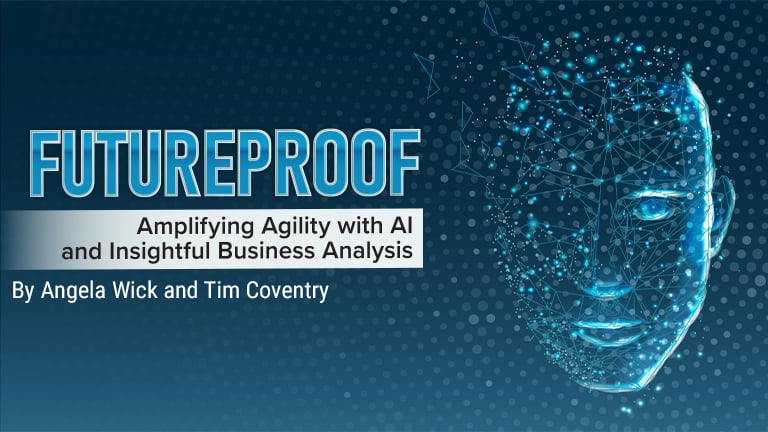The Future of Business Analysis in an AI-Driven World
Disclaimer: The views and opinions expressed in this article are those of the authors and may not reflect the perspectives of IIBA.
Receive free IIBA updates and exclusive content!

These days, technology moves so fast that it’s often hard to fully grasp what it means for organizations, let alone daily life. In this fast-paced environment, business analysis professionals truly shine. As AI continues to reshape the economy, they’re being called upon to adopt new strategies and mindsets to help organizations successfully navigate this complex and competitive landscape.
Inspired by the recent launch of Futureproof: Amplifying Agility with AI and Insightful Business Analysis, our recent episode of Business Analysis Live explores the intersection of AI and business analysis. Special guest Angela Wick joined us to elaborate on the themes of her new book, co-authored with Tim Coventry. Futureproof focuses on the urgent need for business analysis in an AI environment, providing a framework for thinking about analysis in an AI-driven world. Two key components of this are upskilling and adapting to the rapid pace of decision-making that technological change demands.
We kicked off the conversation by reflecting on the energy at the BBC conference (where Futureproof sold out) and the excitement around Analysis Everywhere, a call to action encouraging practitioners to unite and share their perspectives. Via a pre-recorded session, Tim joined us at the top of the show to highlight the pressures leaders face today and the critical role of business analysis in ensuring ethical AI implementations that are aligned with business goals.
That’s a lot to unpack! In case you missed it, let’s explore the key takeaways from our latest deep dive.
Embracing Hypothesis Creation, Proof of Concept, and Fast-Fail
Angela highlighted the significance of hypotheses and experiments in the fast-moving, complex tech environment. When it comes to defining and creating value-driven hypotheses and experiments aligned with an organization’s strategy, there are few more capable than a business analysis professional. This approach allows for testing assumptions quickly and efficiently, leading to informed decision-making processes.Second, the emphasis on hypothesis creation and proof of concept aligns with the idea of learning and testing assumptions rapidly. Business analysis professionals can drive better outcomes for their organizations by linking hypotheses to user behaviours and business results. This shifts the focus from deterministic solutions to a more agile and adaptable mindset, which is essential in the dynamic AI landscape.
Finally, the concept of a fast-fail approach encourages professionals to iterate quickly, learn from failures, and adapt their strategies accordingly. Doing so allows for continuous improvement and innovation, essential in leveraging AI technologies well.
Upskilling in the Age of AI
Upskilling is always important for business analysis professionals. With the advent of AI, however, it has become essential.According to Angela, upskilling now goes beyond just taking courses and acquiring knowledge. Rather, true skill development comes from a combination of knowledge and experience. That means seeking out examples to follow, collaborating with others, and practising skills in different contexts. Upskilling should also involve social learning, mentoring, coaching, and the practical application of skills.
Classes are only the starting point in skill development—true mastery comes from repeated practice, feedback, and observation. By engaging with different levels of complexity and seeking feedback from various sources, business analysis professionals can elevate their skills effectively.
The AI Accelerator Framework
One of the book’s key concepts is the AI Accelerator Framework, which helps business analysis professionals understand the integration of analysis into various aspects of business operations. It’s designed to provide a structured approach to understanding how analysis aligns with business results, software development, and assets.
The framework starts with assets, which are continuous and living components that business analysis professionals create to facilitate decision-making, conversations, and analysis in an AI-driven world. These assets encompass various elements such as business architecture, business process models, and business rules. When practitioners see assets as enduring resources that are consistently in use, they can operate with greater efficiency and speed, eliminating the need to start fresh at each stage.
The next step in the framework involves hypotheses and experiments. This is where formulating value-driven hypotheses and conducting experiments that align with the organization’s strategy become critical. This stage allows business analysis professionals to test assumptions, gather data, and inform decision-making processes effectively.
At the top of the framework’s pyramid lies business results, which emphasize the link between user behaviours, deliverables, team tasks, and business outcomes. Practitioners can demonstrate the impact of their work on the organization’s strategic goals and objectives by connecting user behaviours to business results.
Ultimately, the AI Accelerator Framework helps business analysis professionals navigate the complexities of an AI-driven world by emphasizing continuous analysis, hypothesis-driven experimentation, and a focus on delivering tangible business outcomes. Through it, practitioners can enhance their understanding of how analysis contributes to organizational success and adapt their practices to meet the evolving demands of the digital landscape.
Closing Thoughts
We covered a lot of ground in this episode, but it’s only a glimpse of what’s possible when business analysis meets AI. If you want to learn more about this fascinating topic, purchase Futureproof at the IIBA Bookstore and watch for the upcoming webinar, What Good, Bad, and Ugly Analysis Looks Like With and Without AI, where Angela and Tim will further explore the concepts from their book.Explore fresh and candid conversations on a wide array of business analysis topics with the Business Analysis Live podcast.
About the Authors

Susan A. Moore, Community Engagement Manager, IIBA

Scott Bennett, Manager, Business Analysis, IIBA
We host Business Analysis Live to discuss business analysis topics and answer questions from our live audience. We have a backlog of upcoming topics and we’re happy to take suggestions. Add a comment to one of our videos to suggest a topic you would like us to cover in an upcoming episode!



